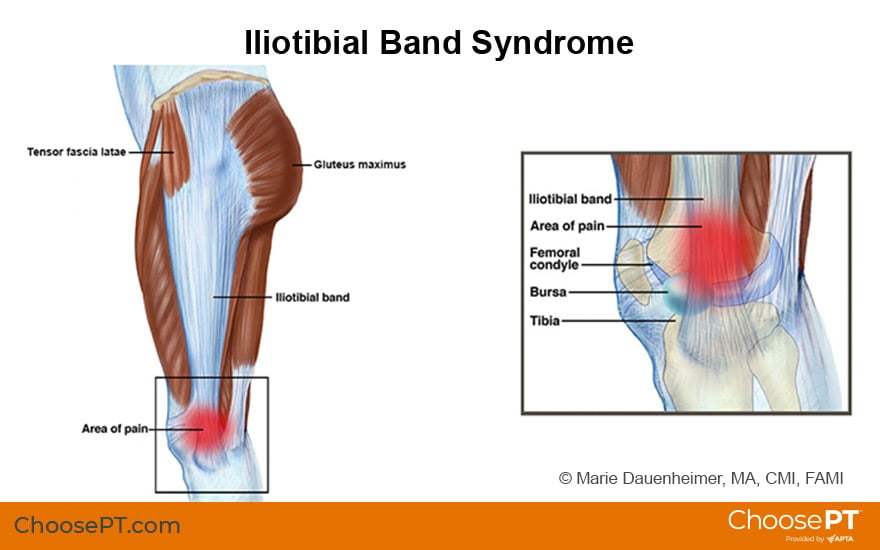Physical Therapy Guide to Iliotibial Band Syndrome (ITBS or "IT Band Syndrome")
Iliotibial band syndrome, or ITBS, is one of the most common overuse injuries of the leg, particularly in individuals involved in endurance sports. It accounts for up to 12% of running injuries and up to 24% of cycling injuries. ITBS is typically treated through physical therapy and a temporary change in activities. Physical therapists help people with ITBS lessen pain, restore movement, and return to activities and sport.
Physical therapists are movement experts. They improve quality of life through hands-on care, patient education, and prescribed movement. You can contact a physical therapist directly for an evaluation. To find a physical therapist in your area, visit Find a PT.
What Is Iliotibial Band Syndrome?
ITBS occurs when excessive irritation causes pain at the outside (or lateral) part of the knee. The iliotibial band, often referred to as the "IT band," is a type of soft tissue that runs along the side of the thigh from the pelvis to the knee. As it approaches the knee, its shape thickens as it crosses a prominent area of the thigh bone (femur) called the lateral femoral condyle before attaching to the tibia. Near the pelvis, it attaches to two hip muscles, the tensor fascia latae and the gluteus maximus.
Irritation and inflammation arise from friction between the IT band and underlying structures when an individual moves through repetitive straightening and bending of the knee. Typically, ITBS pain occurs with overuse during activities such as running and cycling.
ITBS involves many lower-extremity structures, including muscles, bones, and other soft tissues. Usually discomfort arises from:
- Excessive contact (friction) between the IT band and thigh bone.
- Poor alignment and/or muscular control of the lower body.
- Prolonged pinching or rubbing forces during repetitive activities.
The common structures involved in ITBS are the:
- Iliotibial band.
- Bursa (a fluid-filled sack that sits between bones and soft tissues to limit friction).
- Hip muscles.

ITBS can occur in:
- Athletes performing repetitive activities, such as squatting, and endurance sports, such as running and cycling.
- Individuals who spend long periods of time in a specific position, such as sitting or standing for a long workday, climbing or squatting, or kneeling.
- Individuals who quickly start a new exercise regimen without proper warm-up or preparation.
Signs and Symptoms
With ITBS you may experience:
- Stabbing or stinging pain along the outside of the knee.
- A feeling of the IT band "snapping" over the knee as it bends and straightens.
- Swelling near the outside of your knee.
- Occasional tightness and pain at the outside of the hip.
- Continuous pain following activity, particularly with walking, climbing, or descending stairs, or moving from a sitting to standing position.
Pain is usually most intense when the knee is in a slightly bent position, either right before or right after the foot strikes the ground. This is the point where the IT band rubs the most over the thigh bone.
How Is It Diagnosed?
Your physical therapist will ask you questions about your medical history and activity regimen. A physical examination will be performed so that your physical therapist can collect movement (range of motion), strength, and flexibility measurements at the hip, knee, and ankle.
When dealing with ITBS, it is also common for a physical therapist to use special tests and complete a movement analysis. This will provide your physical therapist with information on the way that you move and how it might contribute to your injury. Your physical therapist may assess your walking/running, lower body alignment, foot structure, and balance. They may ask you to repeat the activity that causes your pain to see firsthand how your body moves when you feel pain. If you are an athlete, your physical therapist might also ask you about your chosen sport, shoes, training routes, and exercise routine.
Typically, medical imaging tests, such as X-ray and MRI, are not needed to diagnosis ITBS.
How Can a Physical Therapist Help?
Your physical therapist will use treatment strategies to focus on:
Range of motion. Often, abnormal motion of the hip, knee, and foot joint can cause ITBS because of how the band attaches to hip muscles. Your physical therapist will assess the motion of your involved leg compared with expected normal motion and the motion of the hip on your uninvolved leg.
Muscle strength. Hip and core weakness can contribute to ITBS. The core refers to the muscles of the abdomen, low back, and pelvis. Core strength is important, as a strong midsection will allow greater stability through the body as the arms and legs go through various motions. For athletes performing endurance sports, it is important to have a strong core to stabilize the trunk and pelvis during repetitive leg motions. Your physical therapist will be able to determine which muscles are weak and provide specific exercises to target these areas.
Manual therapy. Many physical therapists are trained in manual therapy, which means they use their hands to move and manipulate muscles and joints to improve motion and strength. These techniques can target areas that are hard to treat on your own.
Functional training. Even when an individual has normal motion and strength, it is important to teach the body how to perform controlled and coordinated movements so there is no longer excessive stress at the previously injured structures. Your physical therapist will develop a functional training program specific to your desired activity or sport. This means creating exercises that will replicate your activities and challenge your body to learn the correct way to move.
Your physical therapist also will work with you to develop an individualized treatment and training program specific to your personal goals. They will offer tips to help you prevent your injury from recurring.
Can This Injury or Condition Be Prevented?
Maintaining core and lower-extremity strength and flexibility and monitoring your activity best prevents ITBS. It is important to modify your activity and contact your physical therapist soon after first feeling pain. Research indicates that when soft tissues are irritated and the offending activity is continued, the body does not have time to repair the injured area. This often leads to persistent pain and altered movement strategies, and the condition becomes more difficult to resolve.
Once you are involved in a rehabilitation program, your physical therapist will help you determine when you are ready to progress back to your previous activity level. They will make sure that your body is ready to handle the demands of your activities so that your injury does not return. You also will receive a program to perform at home that will help you maintain the improvements that you gained during rehabilitation.
What Kind of Physical Therapist Do I Need?
All physical therapists are prepared through education and clinical experience to treat a variety of conditions or injuries. You may want to consider:
- A physical therapist who is experienced in treating people with orthopedic, or musculoskeletal, injuries.
- A physical therapist who is a board-certified clinical specialist or who has completed a residency in orthopedic or sports physical therapy, as they will have advanced knowledge, experience, and skills that apply to an athletic population.
You can find physical therapists who have these and other credentials by using Find a PT, the online tool built by the American Physical Therapy Association to help you search for physical therapists with specific clinical expertise in your geographic area.
General tips when you're looking for a physical therapist (or any other health care provider):
- Get recommendations from family and friends or from other health care providers.
- When you contact a physical therapy clinic for an appointment, ask about the physical therapists' experience in helping people with ITBS.
- Be prepared to describe your symptoms in as much detail as possible, and report activities that make your symptoms worse.
The American Physical Therapy Association believes that consumers should have access to information that could help them make health care decisions and also prepare them for their visit with their health care provider.
The following articles provide some of the best scientific evidence related to physical therapy treatment of ITBS. The articles report recent research and give an overview of the standards of practice both in the United States and internationally. The article titles are linked either to a PubMed* abstract of the article or to free full text, so that you can read it or print out a copy to bring with you to your health care provider.
Baker RL, Souza RB, Rauh MJ, Fredericson M, Rosenthal MD. Differences in knee and hip adduction and hip muscle activation in runners with and without iliotibial band syndrome. PM R. 2018;10(10):1032–1039. Article Summary in PubMed.
Baker RL, Fredericson M. Iliotibial band syndrome in runners: biomechanical implications and exercise interventions. Phys Med Rehabil Clin N Am. 2016;27(1):53–77. Article Summary in PubMed.
Aderem J, Louw QA. Biomechanical risk factors associated with iliotibial band syndrome in runners: a systematic review. BMC Musculoskeletal Disord. 2015 Nov 16;16:356. Article Summary in PubMed.
Strauss EJ, Kim S, Calcei JG, Park D. Iliotibial band syndrome: evaluation and management. J Am Acad Orthop Surg. 2011;19:728–736. Article Summary in PubMed.
Ellis R, Hing W, Reid D. Iliotibial band friction syndrome: a systematic review. Man Ther. 2007;12:200–208. Article Summary in PubMed.
Fredericson M, Weir A. Practical management of iliotibial band syndrome in runners. Clin J Sports Med. 2006;16:261–268. Article Summary in PubMed.
Fredericson M, Wolf C. Iliotibial band syndrome in runners: innovations in treatment. Sports Med. 2005;35:451–459. Article Summary in PubMed.
Fredericson M, Cookingham CL, Chaudhari AM, et al. Hip abductor weakness in distance runners with iliotibial band syndrome. Clin J Sports Med. 2000;10:169–175. Article Summary in PubMed.
* PubMed is a free online resource developed by the National Center for Biotechnology Information. PubMed contains millions of citations to biomedical literature, including citations in the National Library of Medicine’s MEDLINE database.
Expert Review:
May 20, 2020
Revised:
May 20, 2020
Content Type: Guide
IT Band Syndrome
PT, DPT, PhD, board-certified clinical specialist in sports physical therapy
Laura Pietrosimone
PT, DPT, PhD, board-certified clinical specialist in sports physical therapy
James E. Zachazewski
PT, DPT, board-certified clinical specialist in sports physical therapy, on behalf of the American Academy of Sports Physical Therapy
You Might Also Like...
Health Tips
Tips for Healthy Cycling From Physical TherapistsMay 6, 2022
Cycling is a repetitive activity, that can lead to discomfort or pain. If you have pain related to cycling, you might have a bike fit problem. These tips
Podcast
Success Story: Overcoming Severe Pain, IT Band Syndrome, and a Labrum TearJan 2, 2020
A woman with a common runner's injury tried everything to get better, but pain caused her to stop all activities, until she received the physical therapy

